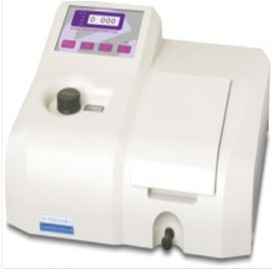How to use Kyushu Shengxin analytical spectrophotometer
1. Before using the instrument, the user should first understand the structure and working principle of the instrument. And the function of each operation knob. Before the power is turned on, the safety of the instrument should be checked, and the power cord wiring should be firm. The ground should be good, the starting position of each adjustment knob should be correct, and then turn on the power switch. Check the instrument before use. The silicone drying cylinder of the amplifier cassette (on the left side of the instrument) should be replaced by dry blue silicone or poured out of the original silicone if it gets wet, and then dried before use.
2. Set the sensitivity knob to "1" (minimum magnification).
3. Turn on the power, the indicator light is on, the selector switch is set to "T", and the wavelength is adjusted to the test wavelength. The instrument was warmed up for 20 minutes.
4. Open the sample chamber cover (the light door closes automatically), adjust the "0" knob to display the number as "00.0", close the sample chamber cover, position the cuvette and the distilled water to correct the position, and make the photocell receive light , Adjust the transmittance "100%" knob to make the number display as "100.0".
5. If "100.0" is not displayed, the number of magnification gears of the microcurrent amplifier can be increased appropriately, but use the lower magnification gear as much as possible, so that the instrument will have higher stability. But after changing the magnification, you must press (4) to recalibrate "0" and "100%".
6. After warming up, press (4) to adjust "0" and "100%" several times in succession, the instrument can perform the measurement work.
7. Measurement of absorbance A Press (4) to adjust "00.0" and "100%" of the instrument, set the selector switch to "A", adjust the absorbance zero adjustment knob so that the number is displayed as ".000", and then the measured The sample moves into the optical path, and the displayed value is the absorbance value of the measured sample.
8. Measurement of concentration C: The selection switch is rotated from "A" to "C", the sample with the calibrated concentration is placed in the optical path, the concentration knob is adjusted so that the number is displayed as the calibration value, and the sample to be measured is placed in the optical path, then Read the concentration value of the tested sample.
9. If the test wavelength is greatly changed, wait for a while after adjusting "0" and "100%" (because the light energy changes sharply, the photocell responds slowly after receiving light, and it takes a period of time for the light to respond to equilibrium), when it stabilizes , Readjust "0" and "100%" to work. Precautions for using the absorption cell (ie cuvette):
â‘ Wash thoroughly, especially after containing protein and other solutions. After drying, a layer of film is formed.
Soaked in 1% cleansing liquid, the decontamination effect is good. When used, rinse with water. It is required that the cup wall does not hang water drops. You can also use a silk brush or soft plastic to make a small brush to clean the cup.
â‘¡ It is strictly forbidden to touch the light-transmitting surface with your fingers, because fingerprints are not easy to clean. It is strictly forbidden to wipe the translucent surface with hard paper and cloth, only lens paper and silk cloth.
â‘¢ Heating and baking are strictly prohibited. When using dry glasses in a hurry, rinse with alcohol and blow dry with cold air. Never use an ultrasonic cleaner.
â‘£ Calibration of the absorption cell: To fix the reference cup and sample cup, write a mark on the frosted glass surface of the cup. Measure the absorbance "A0" with the reference cup and sample cup containing the reference solution. After the sample cup is replaced with the sample solution, the measured absorbance is "A1", then the corrected actual absorbance A is: A = A1-A0

A toilet is a piece of sanitary hardware that collects human urine and feces, and sometimes toilet paper, usually for disposal. Flush toilets use water, while dry or non-flush toilets do not. They can be designed for a sitting position popular in Europe and North America with a toilet seat, with additional considerations for those with disabilities, or for a squatting posture more popular in Asia (see squat toilet). In urban areas, flush toilets are usually connected to a sewer system that leads to septic tanks in isolated areas. The waste is known as blackwater and the combined effluent including other sources is sewage. Dry toilets are connected to a pit, removable container, composting chamber, or other storage and treatment device, including urine diversion with a urine-diverting toilet.
Flush toilets, portable toilet, camping toilet, public toilet, smart toilet, bathroom toilet, installing a toilet, squat toilet, luxury toilet
Zhejiang Yinglin Luggage Co. Ltd , https://www.yllcluggages.com
